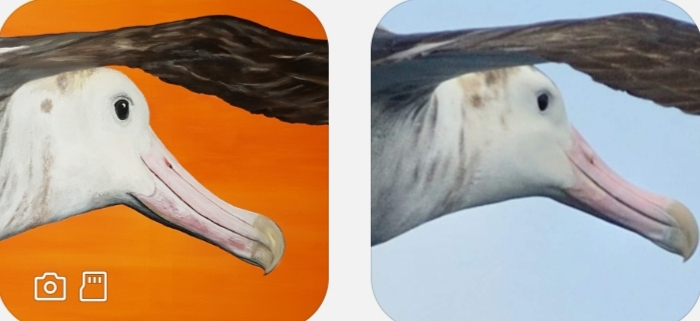
Amsterdam Albatross painted by Birgit Bührlé (left) from a photograph taken at sea by Kirk Zufelt (right)
Alexandre Corbeau (Centre d’Études Biologiques de Chizé, Villiers en Bois, France) and colleagues have published in the journal Animal Conservation on at-sea tracking of Amsterdam Diomedea amsterdamensis and Wandering D. exulans Albatrosses in relation to the presence of fishing vessels in the southern Indian Ocean.
The paper’s abstract follows:
“Many seabirds are attracted to fishing boats where they exploit foraging opportunities, often involving bycatch‐related mortality. Bycatch risk is generally estimated by overlapping seabirds foraging ranges with coarse‐scale monthly maps of fishing efforts, but a more direct estimation would be the time birds actually spend attending fishing boats. Here we matched data from Automatic Identification Systems from all declared boats in the Southern Ocean, with 143 simultaneous foraging trips from all populations of large albatrosses (Diomedea amsterdamensis and Diomedea exulans) breeding in the Indian Ocean (Marion, Crozet, Kerguelen, Amsterdam islands). We quantified and compared real‐time co‐occurrence between boats and albatrosses, at different scales (100, 30 and 5 km). We also examined to what extent co‐occurrence at a large‐scale (5×5° grid cell) predicted fine‐scale attendance (5 km). Albatrosses on average spent about 3 h per trip attending fishing boats (<5 km) at both Amsterdam and Marion and about 30 h per trip at Kerguelen. In all populations, >90% of declared fishing boat attendances occurred within Economic Exclusive Zones (EEZ) where bycatch mitigation measures are enforced. Outside EEZs, birds from all populations to a large extent also attended non‐fishing boats. Fishing boat density at a large scale (5 × 5°, 100 km) was a poor predictor of time spent attending fishing boats (<5 km) across populations. Our results indicate a large variation in fishing boat densities within the foraging ranges of different populations and in the time birds spent attending boats. We discuss the pros and cons of considering bycatch risk at a large geographical scale and methods that can be implemented to improve the estimation of seabird vulnerability to fishing activities when fine‐scale data are available, particularly for the conservation of those highly threatened species.”
Reference:
Corbeau, A., Collet, J., Orgeret, F., Pistorius, P. & Weimerskirch, H. 2021. Fine‐scale interactions between boats and large albatrosses indicate variable susceptibility to bycatch risk according to species and populations. Animal Conservation doi.org/10.1111/acv.12676.
John Cooper, ACAP Information Officer, 25 February 2021

 English
English  Français
Français  Español
Español